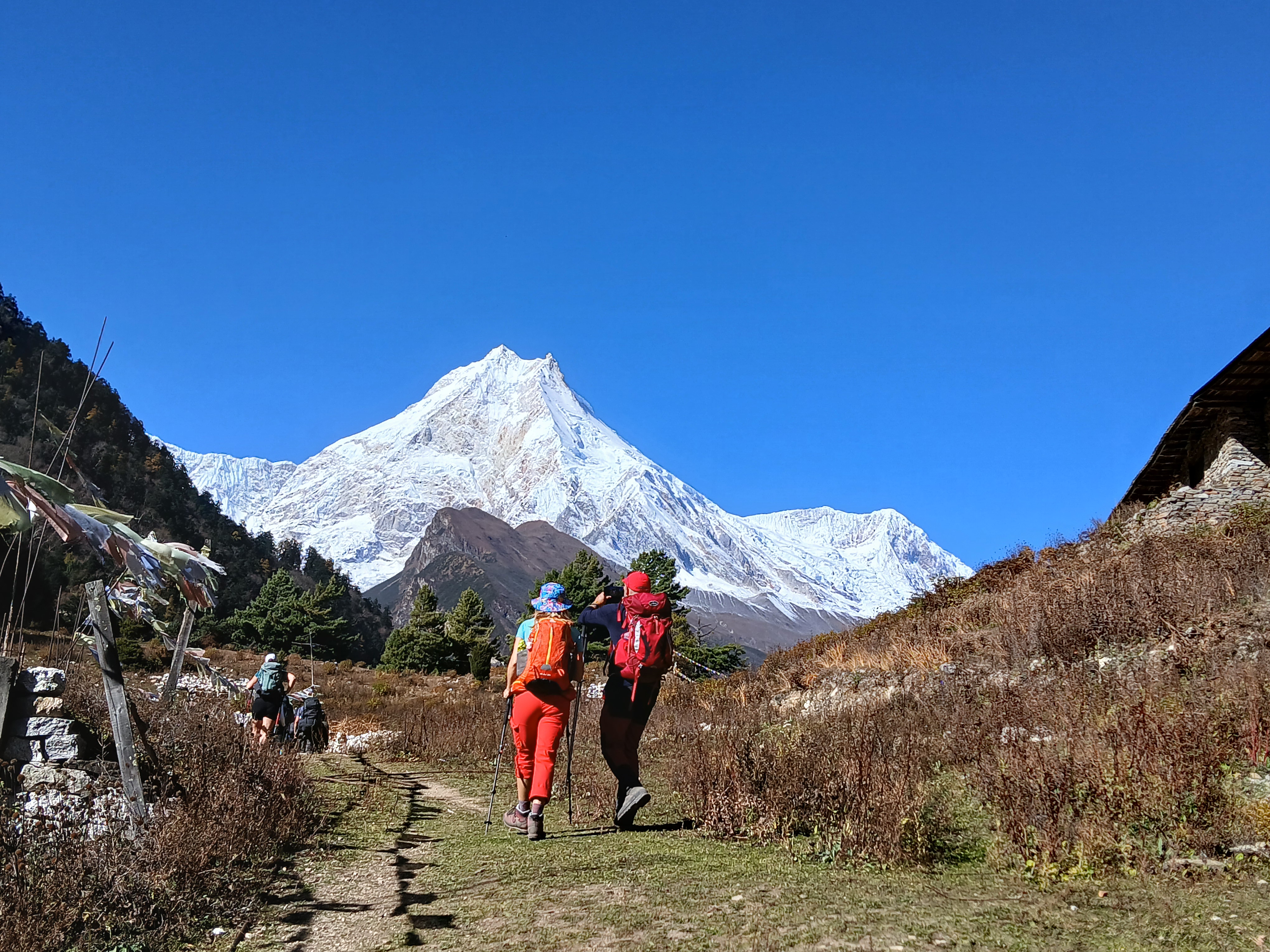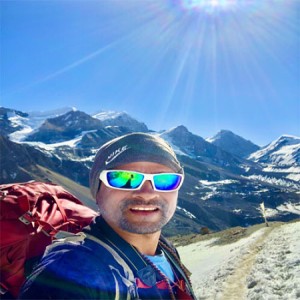How Difficult is the Manaslu Circuit Trek? A Realistic Guide?
The Manaslu Circuit Trek is considered moderately to highly challenging, ideal for experienced trekkers with good physical fitness. The trail spans 14 to 18 days, covering rugged terrain, steep ascents, and altitudes exceeding 5,100 meters at Larkya La Pass—the highest and most demanding point. Daily trekking hours range from 6 to 8, often on narrow trails with rocky sections, landslide-prone areas, and suspension bridges. The remote location limits access to medical care and logistics, adding to the challenge. Altitude sickness is a concern due to the rapid gain in elevation, so proper acclimatization is critical. While no technical climbing is involved, mental resilience and preparation are essential. The trek offers immense rewards—pristine mountain views, cultural immersion in Tibetan-influenced villages, and a less-crowded experience compared to the Annapurna or Everest regions. With proper training and guided support, the Manaslu Circuit is both achievable and deeply fulfilling.
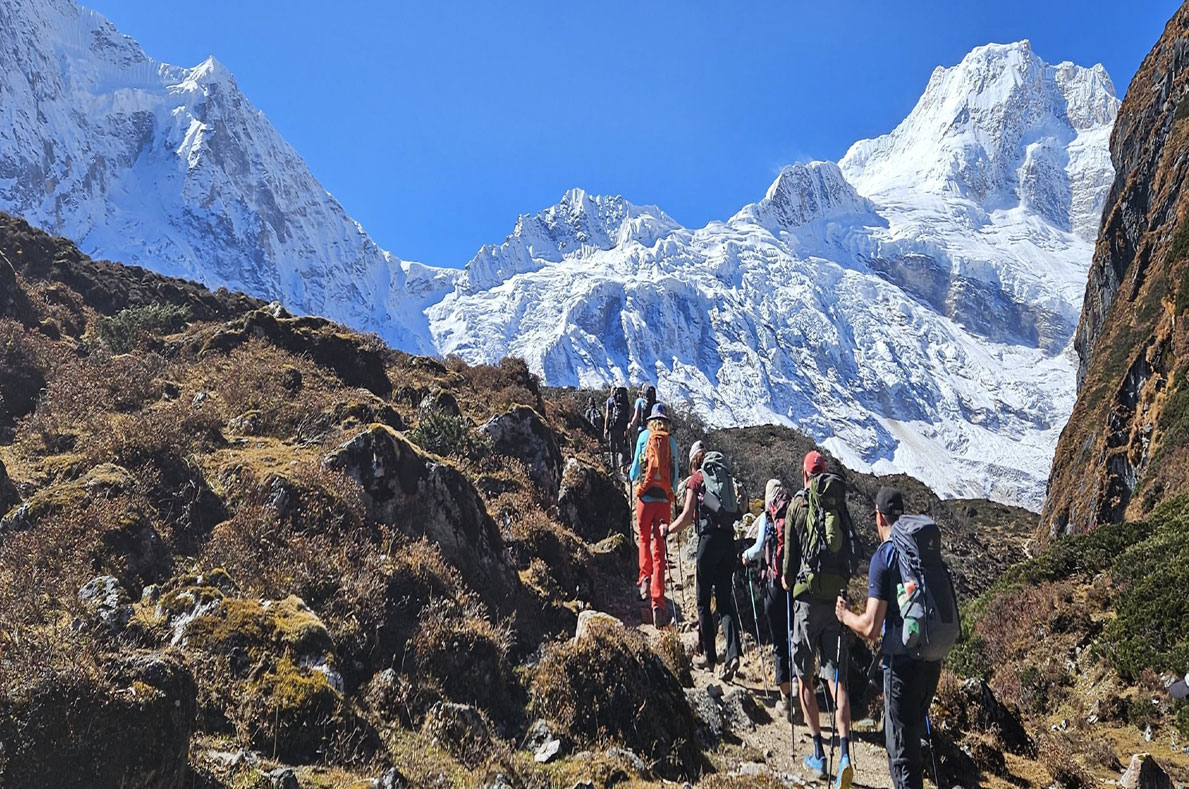
Best Time to Trek the Manaslu Circuit: Weather, Seasons & Tips
The best times to trek the Manaslu Circuit are during spring (March to May) and autumn (late September to early December). These seasons offer the most stable weather, clear skies, and excellent mountain views. In spring, blooming rhododendrons and mild temperatures make the trek especially scenic. Autumn is the most popular due to post-monsoon clarity and dry conditions. Winter (December to February) brings snow and freezing temperatures, particularly around Larkya La Pass, making the trail risky and often impassable. The monsoon season (June to August) is not recommended due to heavy rainfall, landslides, and leeches. Regardless of the season, weather in high altitudes can be unpredictable, so layered clothing and rain protection are essential. Starting early each day helps avoid afternoon clouds and winds. Hiring a licensed guide is mandatory and highly beneficial for safety and navigation, especially in less-traveled months. Planning around seasons ensures a safer, more enjoyable trek.
Manaslu Circuit vs Annapurna Circuit: Which Trek is Better?
The Manaslu and Annapurna Circuits are two of Nepal’s most iconic treks, each offering distinct experiences. The Manaslu Circuit is more remote, less crowded, and culturally immersive, passing through Tibetan-influenced villages and pristine landscapes. It requires a special permit and a licensed guide, adding to its exclusivity. The Annapurna Circuit, in contrast, is more developed with better infrastructure, a wider range of accommodations, and easier access. It’s ideal for first-time trekkers seeking a balance of comfort and adventure. Both treks offer dramatic scenery and high passes—Larkya La (5,160m) for Manaslu and Thorong La (5,416m) for Annapurna. However, road construction has impacted the Annapurna experience in the lower sections, whereas Manaslu retains a more rugged, authentic feel. If you seek solitude, raw nature, and cultural depth, Manaslu is superior. For greater convenience, flexibility, and diverse landscapes, Annapurna is better. Ultimately, your choice depends on your trekking style and expectations.
Manaslu Circuit vs Everest Base Camp: Which Trek is Better, and difficult?
The Manaslu Circuit and Everest Base Camp (EBC) treks both offer iconic Himalayan experiences, but they differ in accessibility, difficulty, and atmosphere. Manaslu is more remote and physically demanding, with longer daily hikes and fewer facilities. The Larkya La Pass (5,160m) is challenging due to steep ascents and unpredictable weather. In contrast, the EBC trek, though still tough, is more commercially developed with a well-marked trail and ample lodges. It reaches a higher elevation—5,364m—but with better acclimatization opportunities. EBC attracts more trekkers, offering a social atmosphere, while Manaslu is ideal for those seeking solitude and raw nature. Manaslu requires a special permit and a licensed guide, enhancing safety and cultural insight. Overall, EBC is better for those wanting a classic Himalayan experience with comfort, whereas Manaslu suits experienced trekkers craving adventure and remoteness. In terms of difficulty, Manaslu generally presents a greater challenge due to its terrain, isolation, and infrastructure.
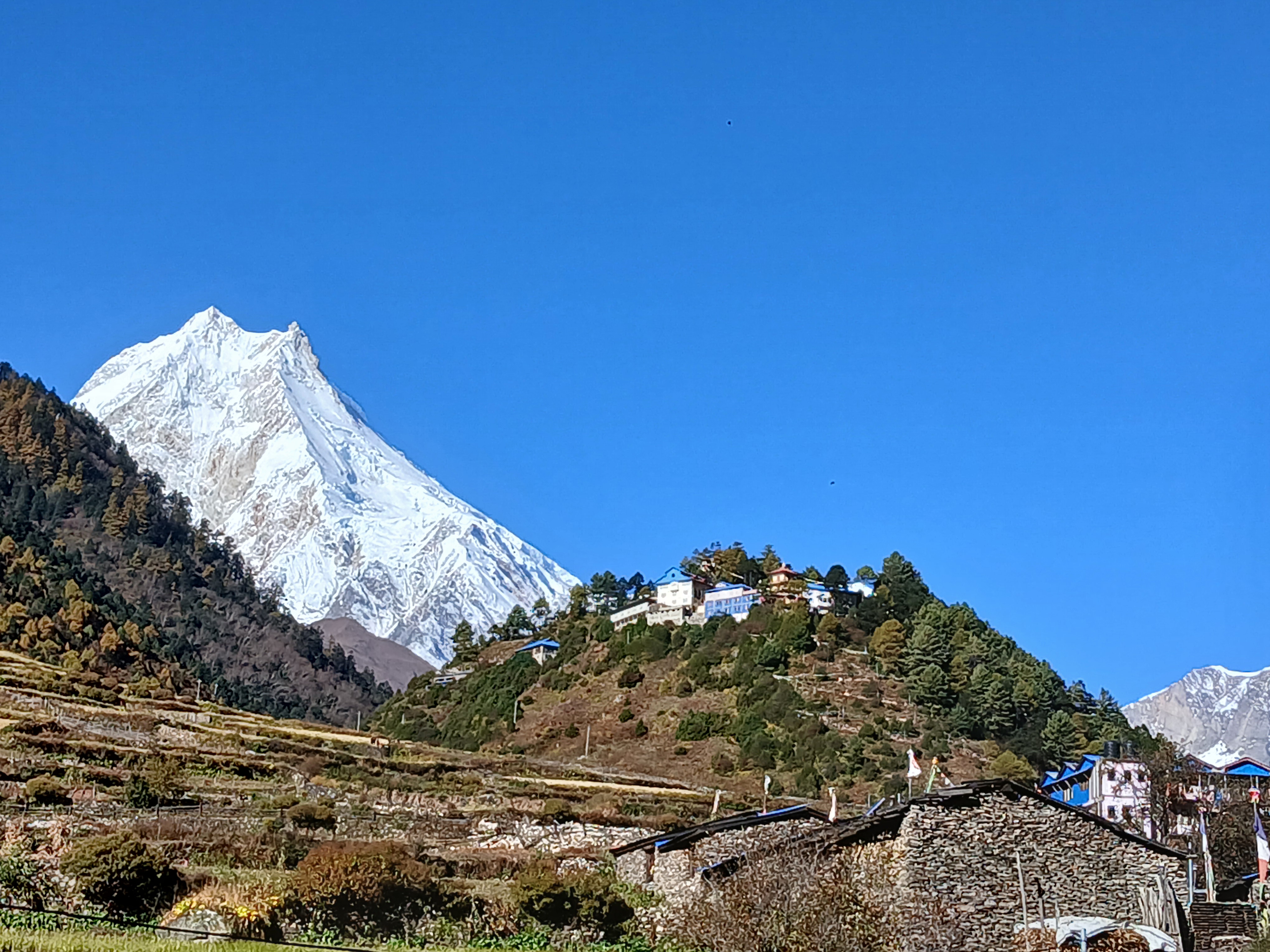
Solo Trekking on the Manaslu Circuit: Is It Possible in 2025?
As of 2025, solo trekking on the Manaslu Circuit is not permitted. Nepal’s trekking regulations mandate that all foreign trekkers in the Manaslu region must be accompanied by a licensed guide and be part of a group of at least two people. This requirement is enforced due to the region’s remoteness, limited infrastructure, and safety concerns, including landslides, altitude sickness, and restricted access zones. Additionally, the Manaslu Circuit lies within a controlled area, requiring special permits such as the Manaslu Restricted Area Permit (RAP), Annapurna Conservation Area Permit (ACAP), and Manaslu Conservation Area Permit (MCAP)—all of which must be processed through a registered trekking agency. While this restriction prevents fully independent trekking, solo travelers can still join group treks or arrange custom itineraries through agencies. Guided treks also enhance the experience by offering cultural interpretation, logistical support, and added safety throughout the journey.
How Much Does the Manaslu Circuit Trek Cost? Budget Breakdown
The Manaslu Circuit Trek typically costs between $1,200 and $1700 per person, depending on the length of the trek, services included, and trekking season. A major portion goes toward permits: the Restricted Area Permit (RAP) costs $100 for the first 7 days (Sept–Nov) and $75 (Dec–Aug), with $15 extra per additional day. Additional permits include the Manaslu Conservation Area Permit (MCAP) and Annapurna Conservation Area Permit (ACAP), both around $30 each. Hiring a licensed guide is mandatory and costs $25–35 per day, while porters cost $20–25 daily. Accommodation in teahouses ranges from $6–10 per night, and meals cost $20–30 per day, depending on location. Transport from Kathmandu to the trailhead (Soti Khola or Machha Khola) via private jeep or public bus ranges from $15–$200. Additional expenses include gear, snacks, internet, charging, and tips. Booking through a trekking agency offers convenience but can raise the total cost.
Acclimatization and Altitude Sickness Tips on the Manaslu Trekking Region
Trekking in the Manaslu region involves reaching elevations above 5,000 meters, making acclimatization crucial for a safe and enjoyable journey. Altitude sickness, or Acute Mountain Sickness (AMS), can occur when the body doesn't adjust well to the decreasing oxygen levels. Common symptoms include headache, nausea, dizziness, and fatigue.
To reduce the risk, ascend gradually and follow the “climb high, sleep low” principle. Spend at least one acclimatization day at locations like Samagaun (3,530m) or Samdo (3,875m), where short hikes to higher altitudes help your body adapt. Keep yourself hydrated, eat a balanced diet, and avoid alcohol or sleeping pills, which can worsen symptoms.
Listen to your body—if symptoms persist, rest or descend. Carrying medication like Diamox (after consulting a doctor) can be helpful. Guides and porters familiar with altitude effects are valuable for safety and decision-making.
Proper acclimatization not only prevents illness but also enhances your trekking experience, allowing you to enjoy the stunning landscapes of the Manaslu region with confidence and vitality.
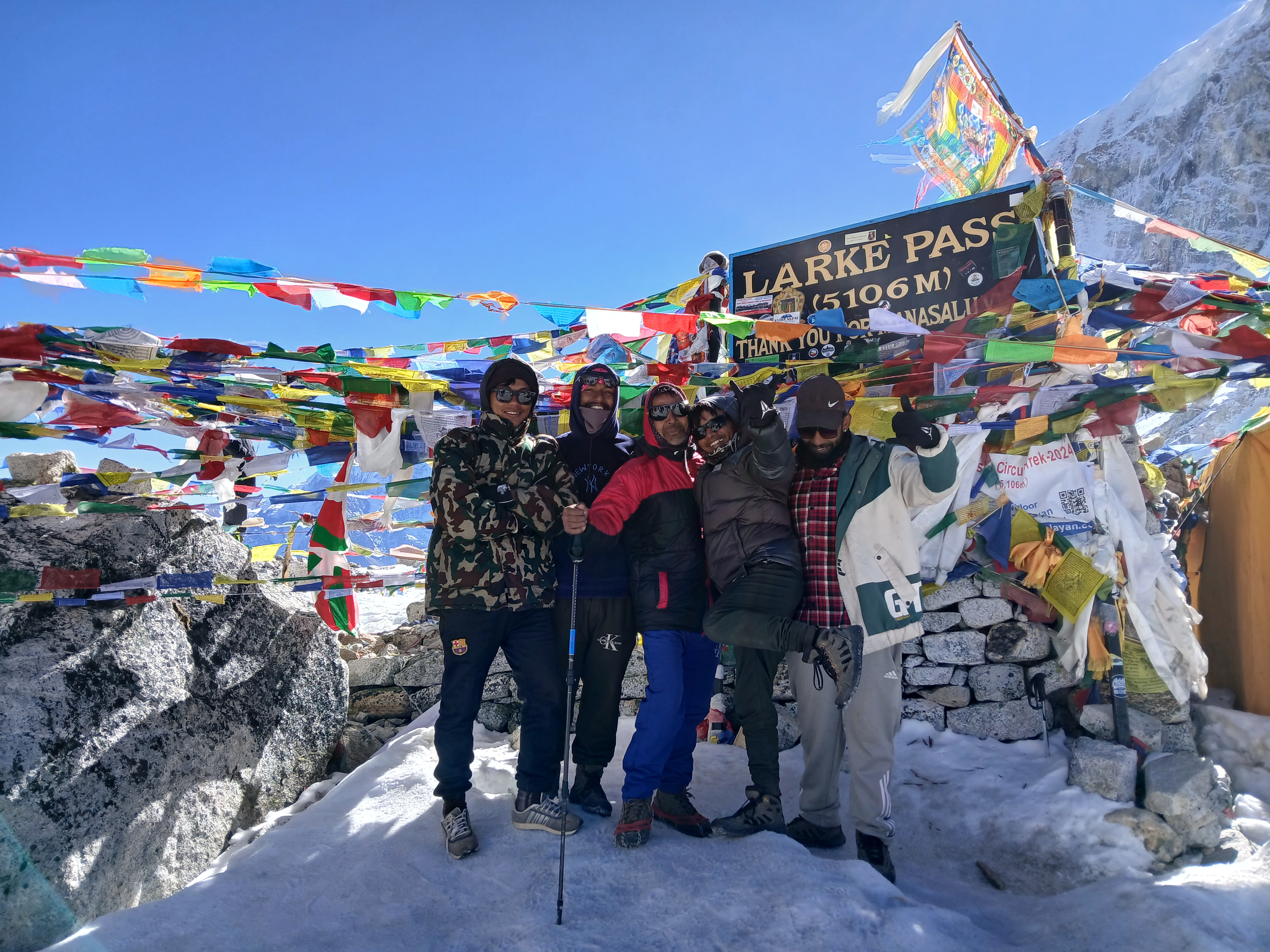
Internet, Mobile Network & Charging on the Trek in Manaslu Region
Internet, mobile network, and charging facilities on the Manaslu Circuit Trek are limited but gradually improving. Wi-Fi is available in some teahouses in larger villages like Samagaun and Lho, usually for an extra fee. However, the connection is often slow and unreliable, especially at higher altitudes or during bad weather. For better connectivity, some trekkers use a local NTC or Ncell SIM card with data, though signal strength varies and is mostly available in lower regions. As for charging, most teahouses offer charging points for a fee, typically ranging from NPR 200–500 per hour. Charging is often done via solar power, so availability may depend on the weather. It’s wise to carry extra batteries or a power bank to stay charged between villages. Being prepared for limited digital access allows for a more immersive and peaceful trekking experience in the remote and stunning landscapes of the Manaslu region.
Wildlife and Natural Beauty in Manaslu Region
The Manaslu region boasts exceptional biodiversity and pristine natural beauty. As you trek through varying altitudes, you'll witness lush rhododendron forests, alpine meadows, and high mountain passes. This ecological diversity supports rare wildlife like snow leopards, Himalayan tahr, red pandas, and musk deer, particularly in the Manaslu Conservation Area. Bird enthusiasts can spot pheasants, Himalayan griffons, and golden eagles. The dramatic landscape transitions from subtropical forests to glacial terrain near Larkya La Pass (5,106m), offering breathtaking views of peaks like Manaslu (8,163m), Himalchuli, and Ngadi Chuli. Rivers like the Budhi Gandaki cut through steep gorges, adding to the region’s raw beauty. Unlike more commercialized trails, Manaslu remains relatively untouched, offering an immersive experience in both nature and solitude. The rich ecosystem and diverse scenery make this trek a haven for nature lovers seeking a blend of adventure and serenity in the heart of the Nepalese Himalayas.
Manaslu Trekking: Food and Accommodation
Food and accommodation on the Manaslu Circuit Trek are basic but sufficient for trekkers. Teahouses along the trail provide lodging with twin-sharing rooms, simple beds, and shared bathrooms. In lower villages like Soti Khola and Jagat, facilities are modest, while higher villages like Samagaun offer slightly better amenities. Don’t expect luxury—bring a sleeping bag for added warmth and comfort.
Meals are typically Nepali and Tibetan dishes. Dal Bhat (rice, lentil soup, vegetables) is a staple, providing great energy. Teahouses also serve noodles, soups, momos, pasta, pancakes, and sometimes limited meat options. Vegetarian meals are recommended for better hygiene and digestion at high altitudes.
Food prices increase with altitude due to transport challenges, and Wi-Fi, hot showers, and charging points often come at an extra cost. Carry cash, as ATMs are not available. Overall, while simple, the food and accommodation along the Manaslu Circuit are reliable and cater well to trekkers’ needs.
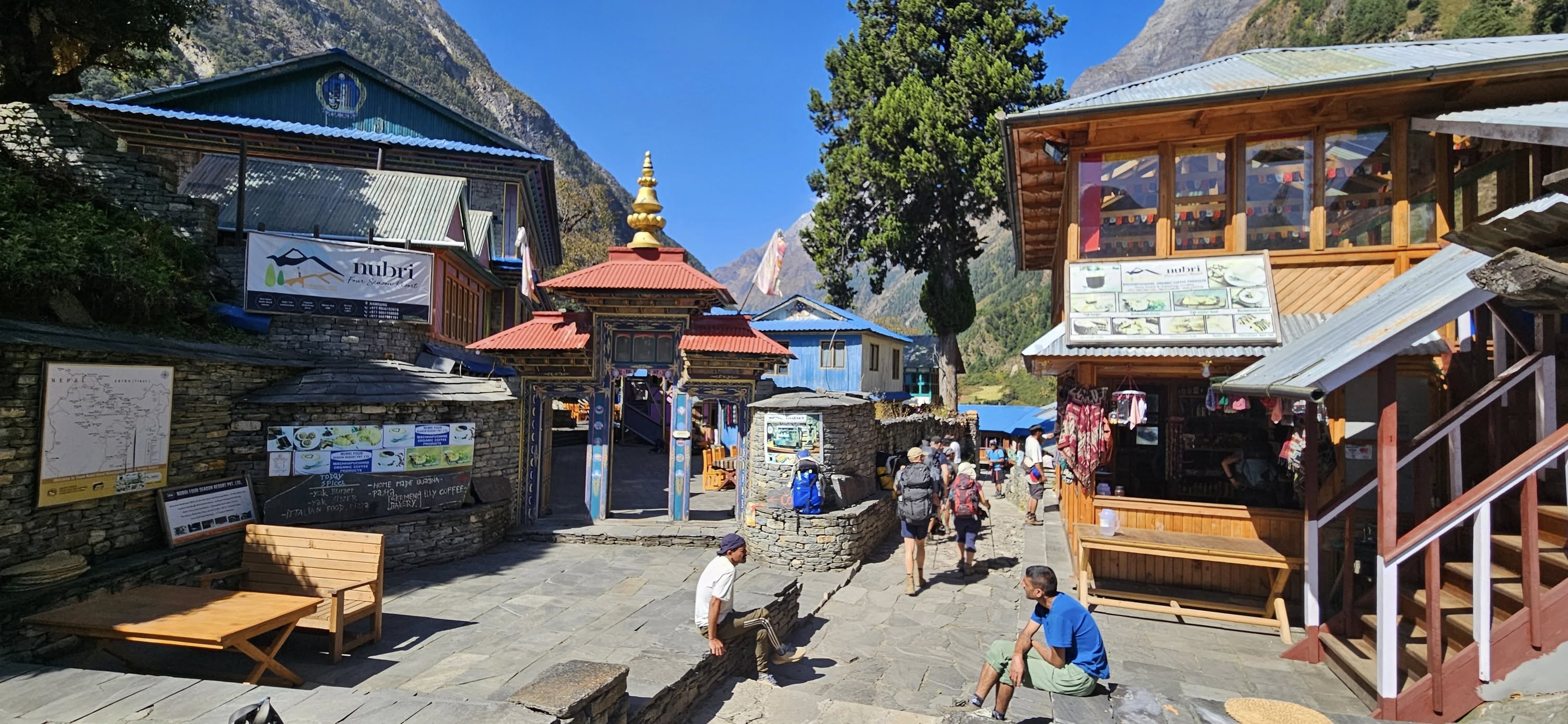
What to Pack for the Manaslu Circuit?
Clothing:
- Base layers (thermal tops and bottoms)
- Trekking shirts (quick-dry)
- Fleece jacket or pullover
- Insulated down jacket
- Waterproof shell jacket and pants
- Trekking pants and shorts
- Warm hat and sun hat
- Buff or neck gaiter
- Gloves (inner and insulated outer)
- Warm socks and liner socks
- Underwear
Footwear:
- Broken-in trekking boots
- Camp shoes/sandals
- Gaiters (optional, for snow)
Gear:
- Backpack (40–60L)
- Daypack (optional)
- Sleeping bag (rated -10°C to -15°C)
- Trekking poles
- Headlamp with extra batteries
- Water bottles or a hydration bladder
- Water purification tablets/filter
- Personal Items:
- Sunglasses (UV protection)
- Sunscreen and lip balm (high SPF)
- Personal toiletries and a quick-dry towel
- First aid kit and personal medication
- Snacks and energy bars
- Power bank and charging cables
Documents & Money:
- Passport and permits (MCAP, ACAP, TIMS)
- Passport-sized photos
- Cash (Nepali Rupees) for the entire trek
Manaslu Circuit Permit Guide: What You Need to Know (2025 Update)
To trek the Manaslu Circuit in 2025, you’ll need three permits: the Manaslu Restricted Area Permit (RAP), Manaslu Conservation Area Permit (MCAP), and Annapurna Conservation Area Permit (ACAP). The RAP is the most regulated, costing USD 100 for the first 7 days, then USD 15 per additional day (from Jagat to Sama Gaun). MCAP and ACAP each cost NPR 3,000 (~USD 22) for foreigners.
A registered guide is mandatory, and solo trekking is not allowed due to the restricted status. You must also book through a government-authorized trekking agency. Carry passport copies and passport-sized photos for permit processing.
Permits are checked at several checkpoints, so don’t skip them. Allow 1–2 days for processing in Kathmandu. Make sure your itinerary aligns with the RAP coverage dates to avoid fines. Following these rules ensures a safe, legal, and unforgettable journey in the Manaslu region.
Top 10 Things to Know Before Trekking the Manaslu Circuit
· Special Permit Required; Unlike other treks in Nepal, the Manaslu Circuit is in a restricted area. You’ll need three permits: the Manaslu Restricted Area Permit (RAP), the Manaslu Conservation Area Permit (MCAP), and the Annapurna Conservation Area Permit (ACAP). A registered guide is mandatory, and solo trekking is not allowed.
· Best Time to Trek: The ideal seasons are autumn (September to November) and spring (March to May). These months offer clear skies, stable weather, and fantastic mountain views. Winter brings heavy snow, especially around Larkya La Pass, and summer is monsoon season with leeches and landslides.
· Remote and Less Crowded: Compared to the Everest and Annapurna regions, the Manaslu Circuit is relatively untouched. Fewer trekkers mean a more serene experience, but also fewer amenities. Be prepared for basic teahouses and limited Wi-Fi or electricity in remote villages.
· Physical Fitness is Key: This trek is considered moderate to challenging, covering roughly 177 kilometers over 14–18 days. You’ll reach altitudes above 5,100 meters at Larkya La Pass. Prior trekking experience or endurance training is highly recommended.
· Cultural Immersion: The route takes you through traditional Gurung and Tibetan-style villages. You’ll experience ancient Buddhist culture, visit monasteries, and see prayer flags fluttering across high mountain passes. It’s a unique blend of nature and heritage.
· Altitude Sickness Awareness: Proper acclimatization is crucial. Many itineraries include a rest day in Samagaon to help your body adjust. Symptoms like headaches, nausea, or dizziness should be taken seriously. Diamox and hydration can help, but descend if symptoms worsen.
· Basic Teahouse Accommodations: You’ll stay in teahouses offering basic rooms, dal bhat meals, and hot tea. Hot showers, phone charging, and Wi-Fi may cost extra or be unavailable at higher altitudes. Carry some cash, as ATMs are nonexistent after Soti Khola.
· Pack Smart: Essentials include a down jacket, sleeping bag (rated to -10°C), trekking poles, water purification tablets, snacks, and a power bank. The weather can shift quickly, so bring layers and waterproof gear.
· Environmental Responsibility: The Manaslu region is ecologically sensitive. Avoid single-use plastics, carry your trash out, and respect local customs. Some areas have limited water sources—be mindful of your usage.
· Combine with Tsum Valley (Optional): For a longer and even more remote experience, consider adding the Tsum Valley extension. This sacred Himalayan valley offers untouched Tibetan culture, ancient monasteries, and fewer trekkers still.
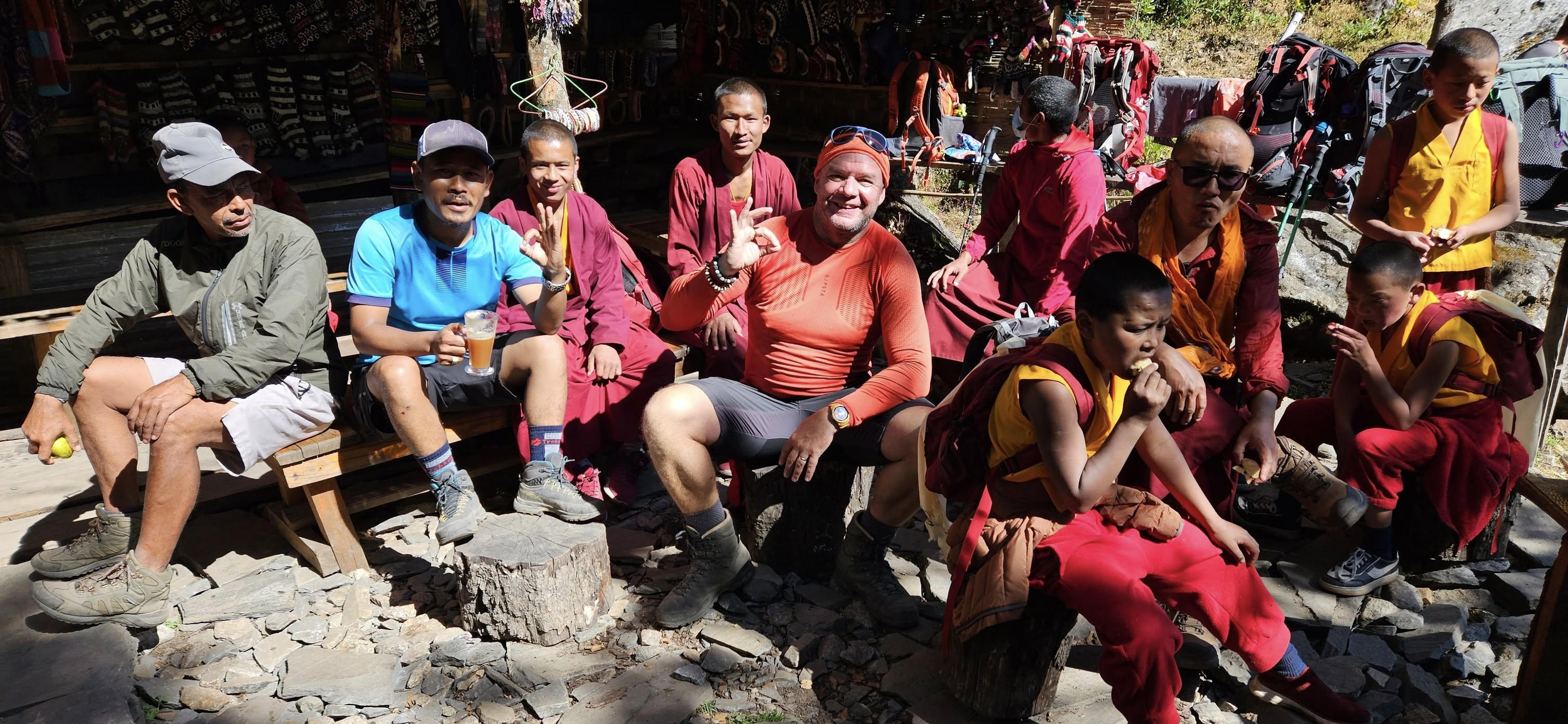
Manaslu Circuit Trek with Tsum Valley: Should You Combine Them?
Combining the Manaslu Circuit Trek with the Tsum Valley extension offers a uniquely rewarding experience for trekkers seeking cultural depth and off-the-beaten-path adventure. While the Manaslu Circuit provides dramatic mountain scenery and the high-altitude Larkya La Pass (5,160m), Tsum Valley offers a serene, spiritual journey through ancient Tibetan Buddhist villages and monasteries untouched by modern development. Adding Tsum Valley requires about 5–7 extra days, making the full trip around 21–24 days in total. This route is ideal for trekkers with sufficient time, physical fitness, and a desire to explore both natural and cultural richness. However, if you're limited on time or prefer a more traditional Himalayan trek focused on alpine landscapes and high passes, the Manaslu Circuit alone may suffice. Ultimately, combining the two enhances the experience with variety, seclusion, and deeper cultural immersion—perfect for those looking to see a more hidden side of Nepal.
Manaslu Circuit Trek Without a Guide: Myth or Reality?
Trekking the Manaslu Circuit without a guide is no longer a reality—it’s now a myth. As of recent regulations by the Government of Nepal, hiring a licensed guide is mandatory for the Manaslu region. This decision was made to enhance safety, support local economies, and manage the protected Manaslu Conservation Area and restricted zones. Additionally, trekkers must obtain special permits, including the Manaslu Restricted Area Permit (RAP), which can only be issued through a registered trekking agency and requires a minimum of two trekkers. While some older blogs may suggest that solo trekking is possible, these are now outdated. Hiring a guide not only complies with regulations but also enriches the experience through local insight, navigation, and logistical support. So, if you’re dreaming of doing the Manaslu Circuit solo and without a guide, it's time to rethink—this trek is a guided adventure by law and design.
How to Train for the Manaslu Circuit Trek: Fitness Tips & Schedule
training for the Manaslu Circuit Trek—known for steep climbs, long walking days, and high altitude—should begin at least 8–12 weeks in advance. A well-rounded plan improves stamina, strength, and mental endurance.
Weekly Fitness Schedule:
Cardiovascular Training (4–5 days/week): Focus on hiking, running, stair climbing, or cycling to build aerobic capacity. Mix steady-state sessions (60–90 mins) with interval training for endurance.
Strength Training (2–3 days/week): Target legs (squats, lunges), core (planks, mountain climbers), and upper body (push-ups, rows) to prepare for carrying a daypack.
Hike with a Pack (1 day/week): Do long hikes (4–8 hours) with a weighted backpack to simulate trek conditions. Gradually increase elevation gain and pack weight.
Flexibility & Recovery (daily): Stretching, yoga, and adequate rest prevent injuries and aid recovery.
Bonus Tip: Include breathing exercises and consider altitude training if possible. Consistency and progression are key to trek readiness.
What to Expect on the Manaslu Circuit: Villages, Views, and Culture
The Manaslu Circuit offers a raw and authentic trekking experience through Nepal’s remote Himalayan region. Along the trail, you’ll pass through diverse villages—from the lowland Gurung settlements to the high-altitude Tibetan-influenced hamlets like Samagaun and Samdo. These villages reflect a rich cultural tapestry, with ancient monasteries, prayer wheels, and traditional stone houses. The views are equally breathtaking: snow-capped peaks, including Manaslu (8,163 m), cascading waterfalls, deep gorges, and lush forests gradually give way to alpine landscapes. The trek crosses the dramatic Larke Pass (5,106 m), offering panoramic vistas that reward your effort. Culturally, expect warm hospitality, unique local dishes, and insights into Buddhist traditions. This circuit is less commercial than Everest or Annapurna, making it ideal for those seeking solitude and connection with both nature and local life. Be prepared for a physically demanding yet deeply enriching journey through one of Nepal’s most spectacular trekking routes.
Altitude Sickness on the Manaslu Circuit: Prevention and Remedies
Altitude sickness is a genuine concern on the Manaslu Circuit, especially as the trail climbs above 3,000 meters and crosses the Larke Pass at 5,106 meters. To prevent altitude sickness, it’s essential to ascend gradually, allowing your body time to acclimatize. Plan for at least one acclimatization day, typically in Samagaun or Samdo. Stay well-hydrated, avoid alcohol, and listen to your body—headaches, nausea, and dizziness can be early signs of Acute Mountain Sickness (AMS).
Remedies include resting, descending if symptoms worsen, and taking medications like acetazolamide (Diamox) as a preventive or treatment option. Garlic soup and ginger tea are popular local remedies, though not medically proven. Porters and guides are familiar with altitude-related issues and can offer support or adjust the itinerary if needed. Being informed, prepared, and cautious can make your high-altitude trek safer and more enjoyable.
T Houses on the Manaslu Circuit: What Accommodation is Really Like
Teahouses on the Manaslu Circuit offer basic yet welcoming accommodation, providing a cozy place to rest after long days of trekking. Rooms are typically simple, with wooden walls, twin beds, and shared bathrooms—don’t expect luxury, but they’re clean and comfortable. In lower villages, facilities are slightly better, while higher elevations may have more limited amenities. Blankets are usually available, but bringing a warm sleeping bag is highly recommended due to cold nights.
Dining rooms serve as communal spaces, often heated by a central stove, where trekkers gather to eat, warm up, and share stories. Menus offer a mix of local and Western dishes, with dal bhat being the staple. Electricity and Wi-Fi are available in some teahouses, usually for a small fee, and charging devices may be limited. Despite the rustic conditions, the warmth and hospitality of the teahouse hosts make the experience truly memorable and culturally immersive.
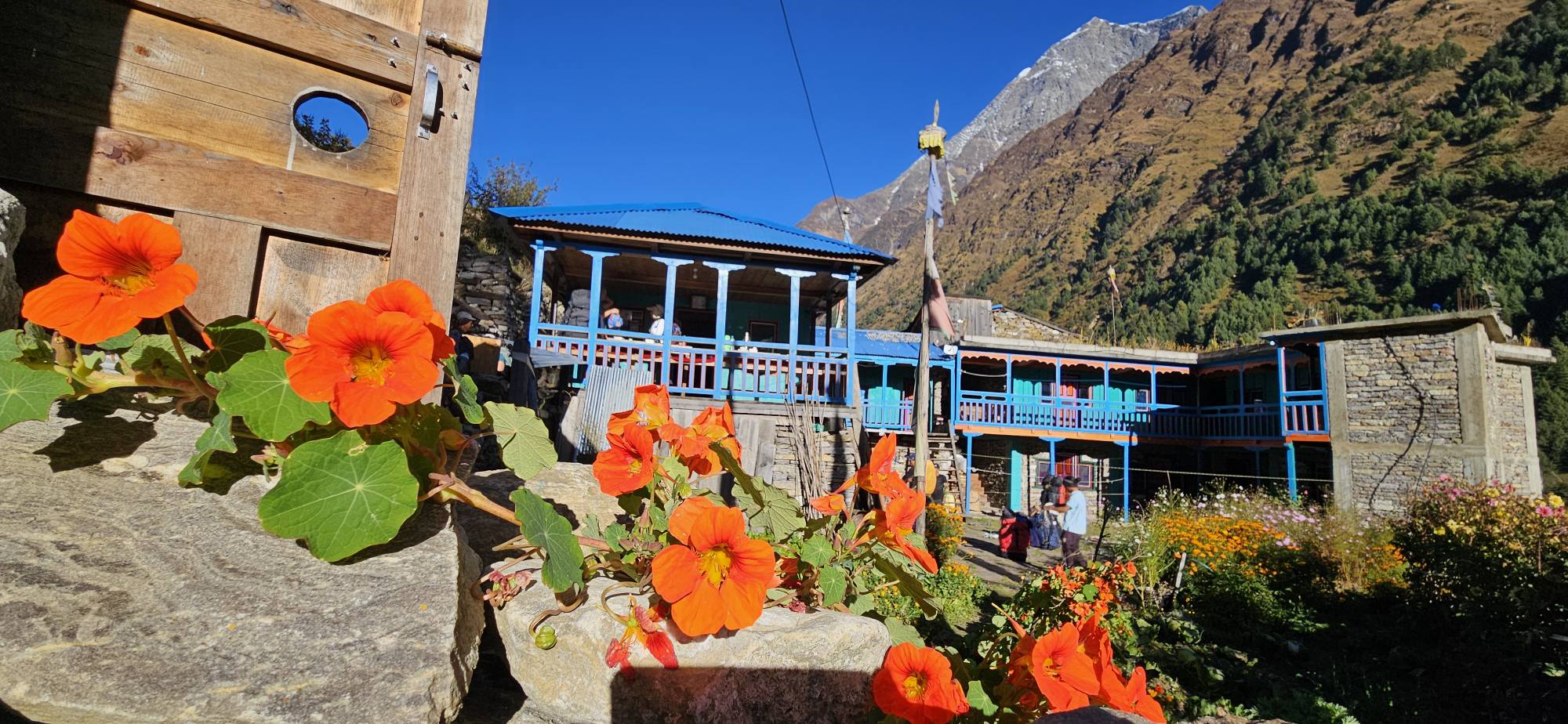
Manaslu Circuit Trek Route: Outline Itinerary
Day 1: Drive from Kathmandu to Machha Khola (8–10 hrs) – Begin your journey with a scenic drive through hills and river valleys.
Day 2: Trek to Jagat (1,340 m) – Follow the Budi Gandaki River through lush forest and small villages.
Day 3: Trek to Deng (1,860 m) – Pass through stone-paved trails, waterfalls, and cultural villages.
Day 4: Trek to Namrung (2,630 m) – Enter the Nubri Valley and start to notice Tibetan influence.
Day 5: Trek to Lho (3,180 m) – See your first glimpse of Mt. Manaslu and visit local monasteries.
Day 6: Trek to Samagaun (3,530 m) – Reach a key village with dramatic views and cultural depth.
Day 7: Acclimatization day in Samagaun – Optional hike to Manaslu Base Camp or Pungyen Gompa.
Day 8: Trek to Samdo (3,860 m) – A short but windy trail to a remote Tibetan village.
Day 9: Acclimatization hike around Samdo – Explore the area or hike toward the Tibetan border.
Day 10: Trek to Dharamsala (4,460 m) – Prepare for the pass with a short, high-altitude day.
Day 11: Cross Larke Pass (5,106 m) and trek to Bimthang (3,590 m) – The toughest but most rewarding day.
Day 12: Trek to Tilije (2,300 m) – Descend through beautiful forests and farmlands.
Day 13: Trek to Dharapani and drive to Besisahar – Rejoin the Annapurna Circuit trail.
Day 14: Drive back to Kathmandu – End your adventure with a full-day drive.
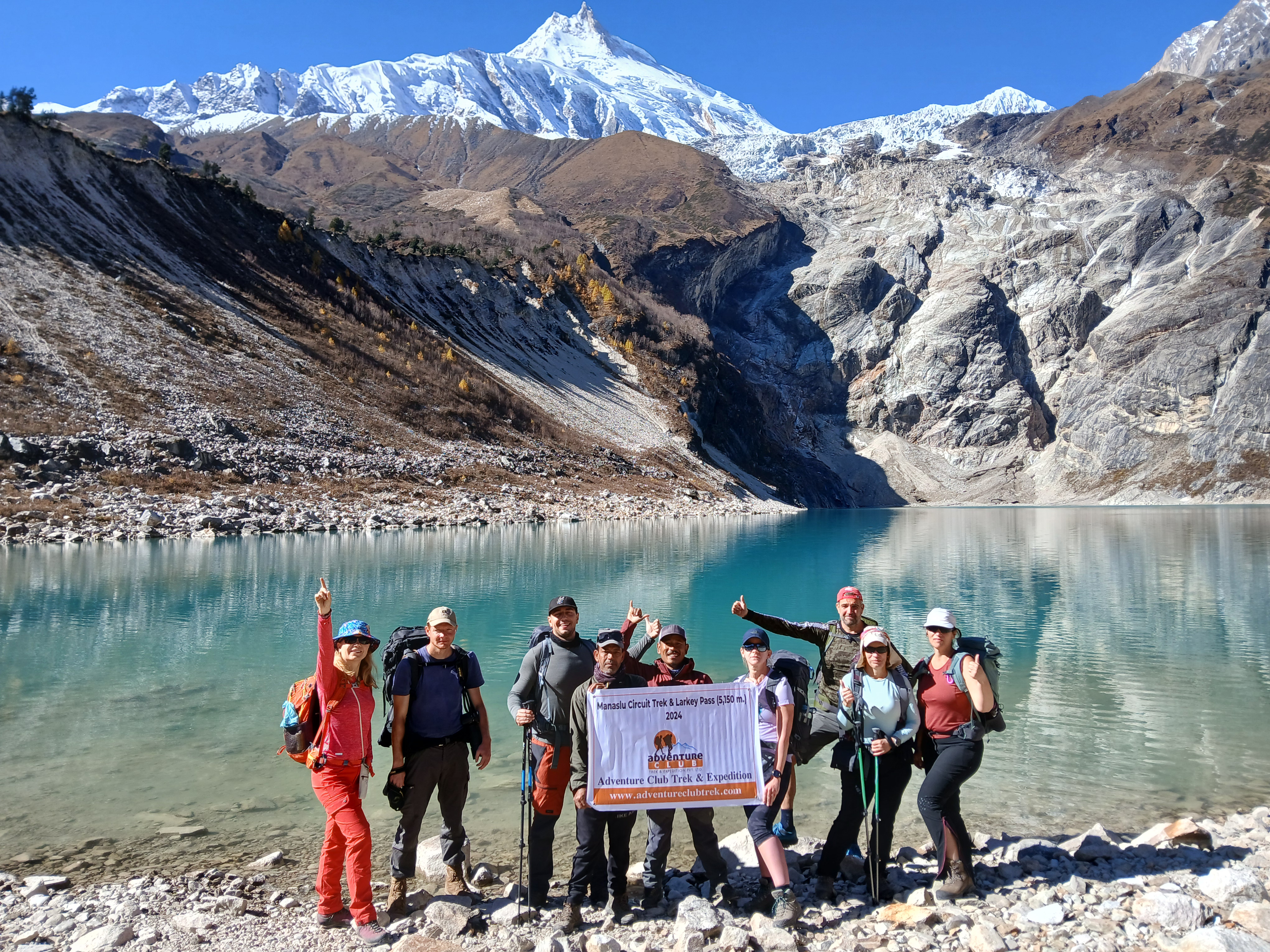
What's Included
Transportation:
- Arrival and departure transfers by a private tourist vehicle.
- Private Jeep/Van for surface transfers between Kathmandu – Machha Khola and Dharapani – Kathmandu, ensuring a comfortable journey.
Accommodation:
- Standard hotel accommodation in Kathmandu on a twin-share basis with bed and breakfast, as per the itinerary.
- Twin-sharing accommodation in the best available teahouses or guesthouses along the trekking route, offering a blend of comfort and authentic experience.
Meals:
- Full board meals (breakfast, lunch, and dinner) are served with tea/coffee during the trek, ensuring proper nutrition and energy.
- A farewell dinner in Kathmandu on the final night to celebrate the journey.
Permits & Documentation:
- Manaslu Circuit Special Trekking Permit is required for restricted area access.
- Annapurna and Manaslu Conservation Area Permits for entry into protected regions.
- Assistance with all necessary paperwork and permit arrangements.
Guides & Support Staff:
- A government-licensed, English-speaking trekking guide trained in wilderness first aid to ensure safety and a smooth trekking experience.
- Porters to carry luggage (1 porter for every two trekkers), easing the trekking burden.
- Assistant guide group size above 4+ people ( 1 assistant guide for 4 people)
- Staff expenses, including food, salary, accommodation, transportation, and medical provisions, are fully covered.
- Comprehensive insurance coverage for all staff, including porters, as per state regulations.
Gear & Equipment:
- A down jacket and sleeping bag (to be returned after the trek).
- Duffel bag for trekking essentials.
- Exclusive Medical Kit Bag, carried by the trek leader for emergencies.
Additional Benefits:
- A trip T-shirt is a memento of the journey.
- A detailed trekking map of the Manaslu Region for navigation and reference.
- Travel and rescue arrangements, ensuring safety throughout the trek.
- All government and local taxes are included, ensuring hassle-free travel.
What's Not Included
Nepal Visa Fees:
- 15 Days – 30 USD
- 30 Days – 50 USD
- 90 Days – 125 USD
Meals:
- Lunch and evening meals in Kathmandu and Pokhara.
Accommodation:
- Extra night accommodation in Kathmandu due to early arrival, late departure, or early return from the trek.
Flights:
- International airfares and flights (can be arranged upon request).
Personal Expenses:
- Alcoholic drinks, bottled water, and cold drinks.
- Personal travel insurance and medical bills.
- Personal trekking equipment.
Tips:
- Tips for guides, porters, and drivers (tipping is expected but not mandatory).
